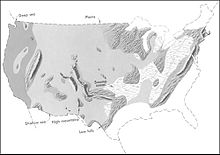- Pennsylvanian
-
This article is about the geologic subperiod. For passenger train, see Pennsylvanian (Amtrak).
System Subsystem/
SeriesStage Age
(Ma)Permian Cisuralian Asselian younger Carboniferous Pennsylvanian Gzhelian 299.0–303.9 Kasimovian 303.9–306.5 Moscovian 306.5–311.7 Bashkirian 311.7–318.1 Mississippian Serpukhovian 318.1–328.3 Viséan 328.3–345.3 Tournaisian 345.3–359.2 Devonian Upper Famennian older Subdivision of the Carboniferous system according to the ICS.[1] The Pennsylvanian is, in the ICS geologic timescale, the younger of two subperiods (or upper of two subsystems) of the Carboniferous Period. It lasted from roughly 318.1 ± 1.3 to 299 ± 0.8. As with most other geochronologic units, the rock beds that define the Pennsylvanian are well identified, but the exact date of the start and end are uncertain by a few million years. The Pennsylvanian is named after the American state of Pennsylvania, where rocks with this age are widespread.
 Generalized geographic map of the United States in middle Pennsylvanian time.
Generalized geographic map of the United States in middle Pennsylvanian time.
The division between Pennsylvanian and Mississippian comes from North American stratigraphy. In North America, where the early Carboniferous beds are primarily marine limestones, the Pennsylvanian was in the past treated as a full fledged geologic period between the Mississippian and the Permian. In Europe, the Mississippian and Pennsylvanian are one more-or-less continuous sequence of lowland continental deposits and are grouped together as the Carboniferous Period. The current internationally used geologic timescale of the ICS gives the Mississippian and Pennsylvanian the rank of subperiods, subdivisions of the Carboniferous Period.
Contents
Life
Fungi
All modern classes of fungi were present in the Pennsylvanian.[2]
Vertebrates
Amphibians were diverse and common; some were several meters long as adults. The collapse of the rainforest ecology in the mid Pennsylvanian (between the Moscovian and the Kasimovian) removed many amphibian species that did not survive as well in the cooler, drier conditions. Reptiles, however, prospered due to specific key adaptations.[3] One of the greatest evolutionary innovations of the Carboniferous was the amniote egg, which allowed for the further exploitation of the land by certain tetrapods. These included the earliest sauropsid reptiles (Hylonomus), and the earliest known synapsid (Archaeothyris). These small lizard-like animals quickly gave rise to many descendants. Reptiles underwent a major evolutionary radiation, in response to the drier climate that proceeded the rainforest collapse.[3][4]
Subdivisions
The Pennsylvanian has been variously subdivided. The international timescale of the ICS follows the Russian subdivision into four stages:
- Bashkirian (oldest)
- Moscovian
- Kasimovian
- Gzhelian (youngest)
North American subdivision is into five stages, but not precisely the same, with additional (older) Appalachian series names following:
- Morrowan stage, corresponding with the middle and lower part of the Pottsville Group (oldest)
- Atokan stage, corresponding with the upper part of the Pottsville group
- Desmoinesian stage, corresponding with the Allegheny Group
- Missourian stage, corresponding with the Conemaugh Group
- Virgilian stage, corresponding with the Monongahela Group (youngest)
The Virgilian or Conemaugh corresponds to the Gzhelian plus the uppermost Kasimovian. The Missourian or Monongahela corresponds to the rest of the Kasimovian. The Desmoinesian or Allegheny corresponds to the upper half of the Moscovian. The Atokan or upper Pottsville corresponds to the lower half of the Moscovian. The Morrowan corresponds to the Bashkirian.
In the European subdivision, the Carboniferous is divided into two epochs: Dinantian (early) and Silesian (late). The Silesian starts earlier than the Pennsylvanian and is divided in three ages:
- Namurian (corresponding to Serpukhovian and early Bashkirian)
- Westphalian (corresponding to late Bashkirian, Moskovian and Kasimovian)
- Stephanian (corresponding to Gzelian).
References
- ^ Gradstein et al. (2004)
- ^ Blackwell, Meredith, Vilgalys, Rytas, James, Timothy Y., and Taylor, John W. Fungi. Eumycota: mushrooms, sac fungi, yeast, molds, rusts, smuts, etc., February 2008, Tree of Life Web Project
- ^ a b Sahney, S., Benton, M.J. & Falcon-Lang, H.J. (2010). "Rainforest collapse triggered Pennsylvanian tetrapod diversification in Euramerica" (PDF). Geology 38 (12): 1079–1082. doi:10.1130/G31182.1. http://geology.geoscienceworld.org/cgi/content/abstract/38/12/1079.
- ^ M. Alan Kazlev (1998) The Carboniferous Period of the Paleozoic Era: 299 to 359 million years ago, Palaeos.org, Retrieved on 2008-06-23
External links
- The Late Carboniferous a Time of Great Coal Swamps, Paleomap project. World map from this time period.
- The Carboniferous - 354 to 290 Million Years Ago, University of California Museum of Paleontology. Information on stratigraphies, localities, tectonics, and life.
- The Pennsylvanian Epoch of the Carboniferous Period: 318 to 299 Mya, Paleos.com
- US Geological Survey comparison of time scales
Categories:
Wikimedia Foundation. 2010.
